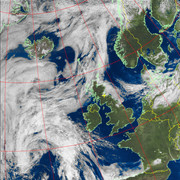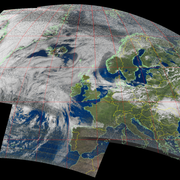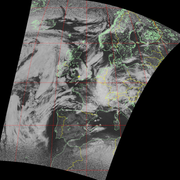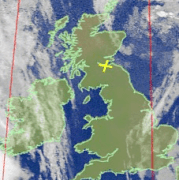This is an old revision of the document!
Table of Contents
OARC VHF Weather Satellite Reception Tips & Tricks

This is the first draft of what will hopefully become a useful club resource for people wanting to do some VHF satellite reception of either NOAA APT signals or the LRPT signal from the Russian meteor satellites. There’s no need to reinvent the wheel as plenty has been written before on this subject. Instead there will be links to other places around the Internet, but also some learned wisdom and tips from OARC members. It is unfinished and may get broken up into separate pages once it becomes unwieldy.
VHF satellite work is the easiest satellite reception work to get into. If you get the bug after doing this consider moving up to L-band HRPT reception, which should doable with a modest antenna. The next step up from that is to geostationary satellites, where you'll be needing amplifiers, filters, and a whole lot of kit. There are a few places on the internet that specialise in this kind of thing.
Contents
General tips/data for APT and LRPT decoding
Frequency list
- NOAA-15: 137.6200
- NOAA-18: 137.9125
- NOAA-19: 137.1000
- Meteor M-N2: 137.1000
Obviously for those of you wanting to do LRPT as well you will have to deal with the overlap and shared frequency of NOAA 19. This is always irritating and there isn't much you can do. An APT signal will destroy a digital LRPT signal, and if you try decoding APT with LRPT in the background it will show discernible shapes, but nothing really useful to work with. The best thing to do is to wait a few days for their orbits to diverge from each other.
APT: FM, 34 kHz signal, set filter bandwidth to around 35-40 kHz. If you’re correcting for Doppler you can maybe go towards the lower of the range to block out more of what you don't need, but if not go for 40 to get the whole thing in and account for the +/- Doppler difference, approximately 3 kHz.
LRPT: FM, 120 kHz signal, set filter bandwidth to around 130-140 kHz. Doppler correction isn’t strictly needed as the demodulator tools can pick out the data and lock onto it just fine. An SNR of around 10 dB will decode fine, but you may even get some data coming through around 5-10 if you're lucky. Just don't expect a great, error-free capture. Once you hit around 15-20 dB you're laughing.
For LRPT work remember that it’s the raw I/Q baseband recording that you want if you aren't decoding live, not an audio recording. For APT you want the audio recording.
If you’re switching between receiving the two types of signal don’t forget to check your Doppler/recording settings are suitable for each one! MM3IIG has lost more than one capture because of this kind of silliness…
If you can avoid DC spikes by using offset tuning or a filter function it can help, particularly with LRPT. If it’s baked into your recording and you're using SatDump then there’s an option to block it as the file is read.
You'll need more gain for LRPT signals because of the similar power but lower bandwidth (power density). This can induce intermod/breakthrough depending on your antenna, location, etc. If that happens you may want to look into bandpass filters for 136-138 MHz.
Audio Samples
Here's a couple of audio samples to test your software setup with. There's a WAV audio recording for APT and an LRPT test with a baseband I/Q WAV recording (i16, 250000 kbps sample rate).
APT Sample
11,025 kHz mono WAV file, (size here)
(link here)
LRPT Sample
250 kHz wide baseband I/Q WAV file, (size here)
(link here)
OARC reception gallery
If you're adding entries please add the start time of the pass, or for composites feel free to specify a time range.
APT Captures
LRPT Captures
To follow.
| Capture | Date | Time(s) (UTC) | Callsign/Name | Notes |
|---|---|---|---|---|
| x | x | x | x | x |




